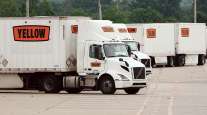Fleets Operating in Health Care Sector Adjust to Surge in Demand Amid Pandemic
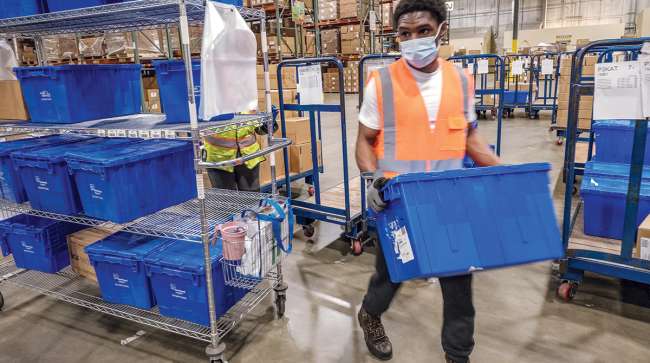
[Ensure you have all the info you need in these unprecedented times. Subscribe now.]
When the COVID-19 outbreak first hit, fleets serving the health care industry responded to sudden shifts in demand while also implementing new safety protocols to protect their drivers and customers.
As Mark Rigdon, vice president of transportation for McKesson Medical-Surgical, explained, the pandemic forced his company to become faster at making decisions.
“There were many complex areas we had to work through,” he said. “I think our teams were very effective at identifying problems, developing alternatives, making the decisions they could and escalating other alternatives to senior leadership.”
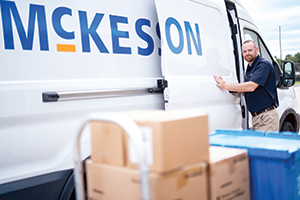
Health care logistics operations were forced to make swift business decisions as the pandemic took hold. (McKesson Medical-Surgical)
Drivers were on the front lines during the pandemic, and their safety was paramount.
McKesson established procedures to protect its more than 1,000 delivery professionals, Rigdon said. These safety protocols, which remain in place today, include maintaining a distance of 10 feet between drivers and others, mandatory use of masks, daily temperature checks and deep cleaning of vehicles and equipment. In some circumstances, McKesson opts for curbside delivery only.
At Cintas Corp., demand for hand sanitizer and N95 respirators increased tenfold in the pandemic, said Scott Farmer, CEO of the Cincinnati-based company, which supplies businesses with work uniforms and other products and services.
“Our supply chain has worked feverishly to satisfy this demand,” he said. “I’m proud of their ability to adapt and persevere in the midst of unprecedented adversity.”
READ MORE: Supply Chain Workers Play Essential Role in Coronavirus Response
Farmer said Cintas provided its health care customers with clean scrubs and towels and provided tens of thousands of customers with disinfectant and sanitizer sprays as well as personal protective equipment, including face masks and face shields.
“Our employee partners have been consistent and diligent in their care of our customers, providing essential products and services to health care facilities, pharmaceutical companies, grocery store chains, food processing plants and many others,” he said.
XPO Logistics saw outbound shipments from facilities into hospital networks surge to as much as 40% above normal levels.
“The shipments were critical medical supplies, including masks, gloves, gowns, IV components, trays and surgical kits,” said Drew Wilkerson, president of XPO’s North American transportation group.
XPO, based in Greenwich, Conn., ranks No. 3 on the Transport Topics Top 100 list of the largest for-hire carriers in North America.
Satish Jindel, founder of SJ Consulting Group, said operating a private fleet can ensure service levels when capacity tightens during demand surges.
Several health care companies utilize dedicated contract carriers.
“It is almost like a private fleet committed to you, but they operate the truck and provide the driver,” Jindel said.
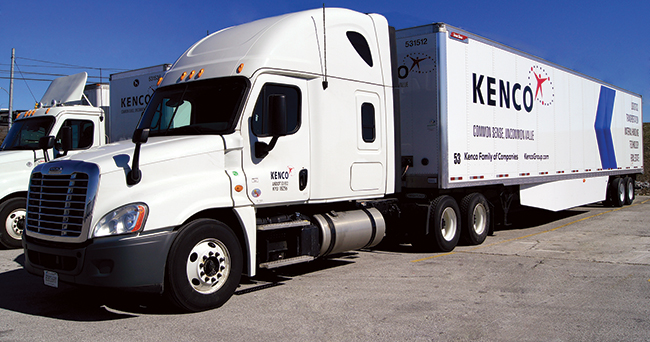
Many medical distribution companies rely on dedicated transportation providers such as Kenco. (Kenco Group)
Many medical distribution companies embrace a dedicated model for the workforce continuity and efficiency it offers, said Michelle Kunde, vice president of operations at Kenco, a logistics provider based in Chattanooga, Tenn.
Kenco, which provides dedicated service to a number of customers in the health care field, shifted internal resources to meet their immediate needs.
“We developed a corporate response team that worked with customers to ensure it adhered to all of the various regulations,” she said.
Steve Martin, senior vice president of dedicated transportation solutions for Ryder Supply Chain Solutions, said transportation providers have always had to manage exceptions, but those situations increased during COVID.
“Now you just have to be ready for it to be part of your day every day,” he said.
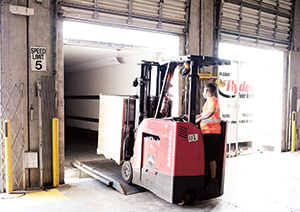
Transportation workers have been wearing masks and maintaining physical distance while performing their essential jobs. (Ryder System)
Ryder provides dedicated contract carriage for health care customers, including one that supplies in-home respiratory services and medical equipment. Because oxygen therapy was in demand during the pandemic, drivers had to not only deliver equipment to patients but also pick it up when it was no longer needed so it could be cleaned and redistributed. “We had to make sure the drivers had the oxygen equipment as a priority as a return shipment,” Martin said.
Jeff Jackson, senior vice president of operations for dedicated contract carriage at Penske Logistics, said customers’ volumes for personal protective equipment and other significant supplies, such as masks and gowns, not only experienced a significant shift but also required more dynamic deliveries.
“We had to dynamically flex our schedules to shift our demand in the product mix and to the geographies that were surging,” he said.
Penske delivered 4 million masks to New York City for its customers.
Having visibility into critical shipments took on greater importance in areas hit hard with COVID. What’s more, health care relies on just-in-time deliveries, which adds complexity when surges occur, Jackson said.
“When you have a load of masks going to New York City and you have people waiting for it and you have to be there from 2:00 to 2:30 because there are five other loads coming in, you need to know where that truck is,” he said.
Northwell Health, a Penske dedicated contract carriage customer, relied on Penske’s Route Status app that shares drivers locations, said Paul Spodek, assistant vice president of supply chain distribution and logistics at the Northwell Health Integrated Distribution Center in Bethpage, N.Y.
“One of the key things that helped us through the pandemic was having that transparency of where the driver was and exactly where the truck was along the route so that the materials director could prepare the staff to get ready to unload the truck and prepare the clinical staff,” Spodek said. “When a hospital is literally running out of supplies — literally down to their last isolation gowns — we could pick up the phone and say the driver is leaving the loading dock as we speak.”
Northwell Health operates an 85,000-square-foot distribution center where it picks, packs and ships to the 23 hospitals and some of the ancillary facilities in its network.
Spodek said Northwell Health never ran out of personal protective equipment, but it was very close.
“We were literally turning deliveries around on the loading dock,” he said.
No one could have predicted the sheer volume of PPE that was needed and the ever-changing item shortages, Spodek said. As one hot item — such as N95 masks — would come back in stock, another item such as bouffant caps became scarce, he added.
For-hire carriers also have played an essential role in the health care sector during the pandemic.
Amos Rogan, less-than-truckload operations leader at Averitt Express, said the fleet tried to prioritize medical and PPE shipments as much as possible within the normal LTL service depending on customer needs and requirements.
“We recognized before the phone rang that we needed to prioritize these types of shipments in order to support the efforts of our health care customers,” he said.
Supply Chain Flexibility
In response to COVID-19, McKesson has secured additional products where available, while also sourcing backup products, allocating supplies to ensure equitable distribution, and initiating business continuity planning, said Chris Alverson, senior vice president of supply chain management at the company.
He added that McKesson is working with manufacturers, industry partners and government agencies to anticipate shortages and respond to unprecedented demand for certain medications and therapies.
One of the challenges with flexing capacity in the health care space is the special training drivers often need.
Penske Logistics has more than 1,100 drivers in the dedicated contract carriage space delivering to hospitals, Jackson said.
“Each hospital is unique in terms of the delivery point,” Jackson said, adding that there are often multiple delivery points within a hospital.
Spodek said Penske conducts robust transport and loading training for the drivers serving Northwell Health.
“Every one of our hospitals is different. The loading docks are different. The supply rooms are in different locations,” he said, adding that Northwell has its items delivered on rolling carts and in plastic shipping totes. “We’ll wrap those and load those on a truck a certain way.”
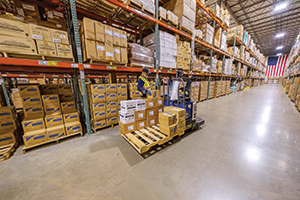
Logistics workers at Northwell Health hustled to meet a surge in demand for personal protective equipment. (Northwell Health)
Within Kenco, Kunde’s network provides high-touch, white-glove service, so dependability and accountability is high. There is a lot of training and coordination that goes into meeting customers’ needs. For example, Kenco handles non-narcotic pharmaceuticals, which are temperature controlled.
“We’ll have dry ice containers, so there are unique handling requirements that require experienced drivers,” Kunde said.
While carriers have been able to flex ground capacity, one of the greatest supply chain issues during COVID-19 has been airfreight capacity constraints, said Bill Freidel, director of life sciences at AIT Worldwide Logistics, which handles global shipments of pharmaceuticals.
Passenger flights have been taken out of the market, so the Itasca, Ill.-based logistics provider has had to look for alternatives and has sourced full aircraft to guarantee airspace, he said.
Freidel said flight patterns are nowhere near where they were the first week in March.
“It is a slow crawl to get back to normal,” he said, adding that AIT has weekly calls with air carriers to stay current on schedules. “It is critical for us to know when those flights are going to be put back on and that we’re even trying to block out capacity on those flights, so we know that we have dedicated space to our clients.”
Although PPE made headlines, pharmaceutical companies also have had to ensure that patients can continue to receive their medications.
“That supply chain needs to remain intact,” said Andrew Schadegg, president of Unitrans International Corp., a wholly-owned subsidiary of AIT Worldwide Logistics.
AIT utilizes the “Wheels Up” clearance process through U.S. Customs, which allows it to submit entry information hours before a load arrives.
“We can take 24-48 hours out of the transportation cycle by managing that customs cycle,” Freidel said.
Keeping Drivers Safe
For fleets across the country, personal protective equipment for drivers is now a common safety standard, as is the use of hand sanitizer.
Companies also have taken steps to reduce physical contact at delivery sites. McKesson, for example, decided to forgo the electronic signature capture for proof of delivery.

Home | Video | Heroes' Photo Gallery
Saluting the men and women of the trucking industry who kept America's essential goods flowing during the coronavirus pandemic.
Heroes: Peter Lacoste | Susan Dawson | James Rogers | Reggie Barrows | Kevin Cooper | Cesar Quintana Moreno
“Rather than having a customer sign the handheld device for proof of delivery, our delivery professionals manually enter the customer’s name to avoid potential contact transmission of any infectious diseases,” Rigdon said.
McKesson has projects underway to improve efficiency at distribution centers and during delivery to customers, such as paperless invoicing, said Ammie McAsey, senior vice president of McKesson’s distribution operations.
Penske also moved to a touchless engagement at the delivery point, which uses a verbal validation.
Kenco, meanwhile, has embraced digital proof of delivery by pivoting the technology it already had, Kunde said.
“We still take paperwork to the facilities, but we hand it over and we don’t take it back,” she said, adding that drivers take a scanned photo of the paper and the signature with their smartphone.
Rogan said Averitt has to change procedures, such as going digital with paperwork, that will lead to better efficiency. The fleet is drawing on those ideas for implementing a new wireless solution that it is beta testing now. He said the new system will allow the fleet to take these practices even further with future development.
While focusing on supply-chain resiliency during this pandemic, some fleets are finding broader business benefits such as quicker turnarounds and better overall efficiency.
“I’m confident we’ll learn from this approach and carry it forward, whether we’re leading normal business operations or navigating a future crisis,” McKesson’s Rigdon said.
Want more news? Listen to today's daily briefing:
Subscribe: Apple Podcasts | Spotify | Amazon Alexa | Google Assistant | More


